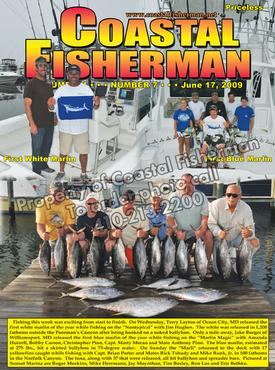


Article by Larry Jock
 DNREC Issues New Shark Regs
DNREC Issues New Shark Regs
The Delaware Department of Natural Resources and Environmental Control has issued modifications to the state’s Tidal Finfish Regulations that take effect June 11 for conservation of Atlantic sharks and for expanding the commercial fishing catch for spiny dogfish.
The regulations bring Delaware into compliance with the Atlantic States Marine Fisheries Commission’s Interstate Fishery Management Plan for Atlantic Coastal Sharks and liberalize commercial requirements in concert with the most recent revision to the ASMFC’s Interstate Fishery Management Plan for Spiny Dogfish.
The Interstate Plan for Coastal Sharks mirrors requirements for shark fishing in federal waters by requiring all states from Virginia to New Jersey to prohibit recreational and commercial landings of 10 shark species known to reproduce in the mid-Atlantic area - silky, tiger, blacktip, spinner, bull, lemon, nurse, scalloped hammerhead, great hammerhead and smooth hammerhead - from May 15 through July 15.
Delaware and all other states also must prohibit recreational and commercial landings of sandbar sharks year-round, except for those commercial fishermen who hold a valid sandbar shark research permit issued by the National Marine Fisheries Service (NMFS). Sandbar sharks have been declared overfished and the population of these slow-to-mature, long-lived species is in need of recovery.
The Delaware Bay is an important pupping and nursery area for this species, which migrates extensively along the East Coast and the Gulf of Mexico. Even though juvenile sandbar sharks are abundant locally in our waters in the summer, these juveniles are critical to the survival of this depleted species and are in need of additional protection. Sandbar sharks can be identified by their relatively large single dorsal fin and sharp teeth. Many shark species resemble the sandbar shark, but sandbars are by far the most abundant shark of this type in the Delaware Bay and nearshore Delaware ocean waters. They can reach weights of several hundred pounds when mature.
Additional revisions to the coastal sharks plan are as follows:
Shore-bound anglers may harvest one shark per day not otherwise prohibited, excluding smooth dogfish sharks, plus one additional bonnethead and one Atlantic sharpnose shark per day.
Recreational fishing vessels will be allowed to harvest and possess one shark not otherwise prohibited per trip, regardless of the number of people on the vessel.
In addition each recreational angler aboard a vessel may harvest and possess one bonnethead and one Atlantic sharpnose shark per person per trip.
All sharks possessed by recreational fisherman must have the heads, tails and fins attached naturally to the carcass prior to landing on shore.
When the NMFS closes the recreational or commercial fishery for any species of shark in federal waters other than the spiny dogfish, the recreational or commercial landing, harvest and possession of that species shall be prohibited in Delaware waters until the NMFS reopens the fishery.
For more information, please contact the Fisheries Section at 302-739-9914.
39 More Subway Cars Sunk at Redbird Reef
The DNREC Division of Fish and Wildlife’s Artificial Reef Program today oversaw the sinking of another 39 New York City subway cars at Delaware’s largest and most popular artificial reef, Redbird Reef.
The subway cars were sunk to expand the capacity of the reef, enhance fisheries habitat, and increase fishing and diving opportunities for thousands of recreational anglers and divers who visit the site each year.
With the total surface area of the cars at more than 2.5 million square feet, Redbird Reef supports a marine life community up to 400 times richer than the natural bottom. In the Mid-Atlantic region, the ocean bottom is usually featureless sand or mud. Subway cars make ideal reef material, because voids and cavities in its structure provide the perfect sanctuary for reef fish. Within a few weeks, blue mussels, sponges, barnacles and soft corals attach to the structure, and in about a year, the reef will be fully productive, resembling natural habitat.
The addition of 39 subway cars brings the total number of sunken subway cars on Redbird Reef to 973. Although the artificial reef was created in 1997, the first subway car sinking at the reef occurred in August of 2001, when 27 cars were sunk. The most recent sinking at Redbird Reef was in April of this year, when 44 subway cars were sunk.
Redbird Reef is now more than 1.3 square nautical miles of ocean bottom located 16 nautical miles off the coast of the Indian River Inlet. Since the reef was first created, a variety of materials have been deployed at the site including the subway cars, 11 large vessels - including decommissioned barges, commercial vessels and tugboats, 86 armored military vehicles and 6,000 tons of ballasted truck tire units. The reef now supports more than 13,000 angler visits per year, up from fewer than 300 in 1997.